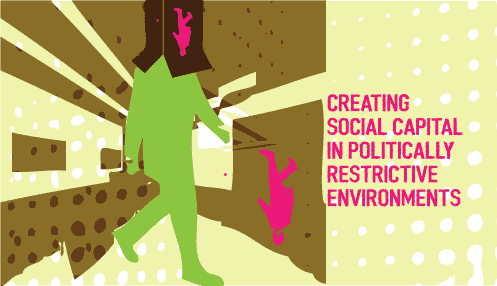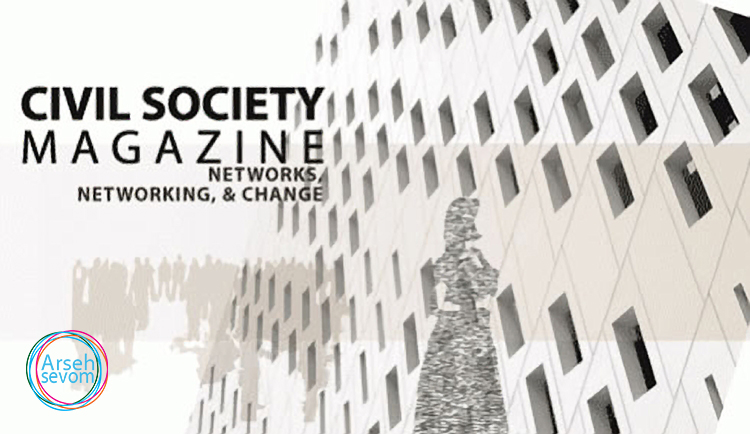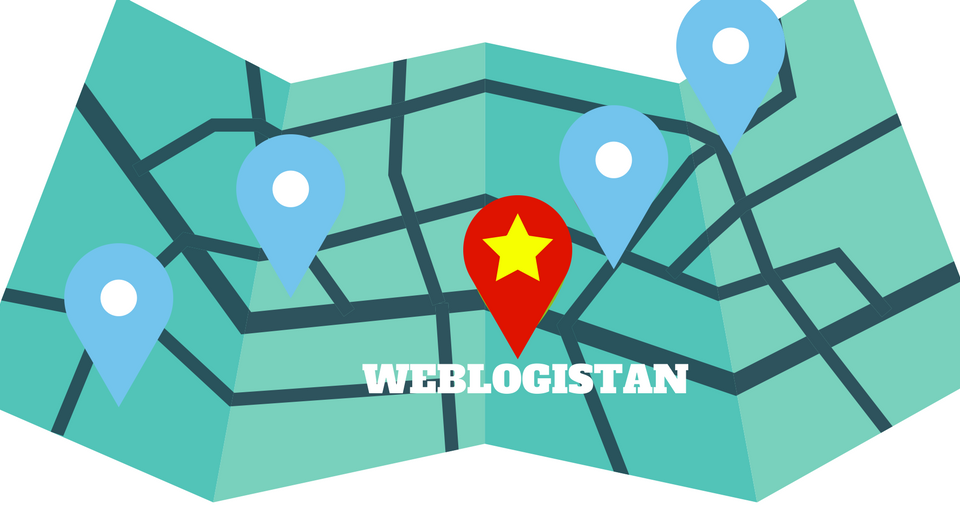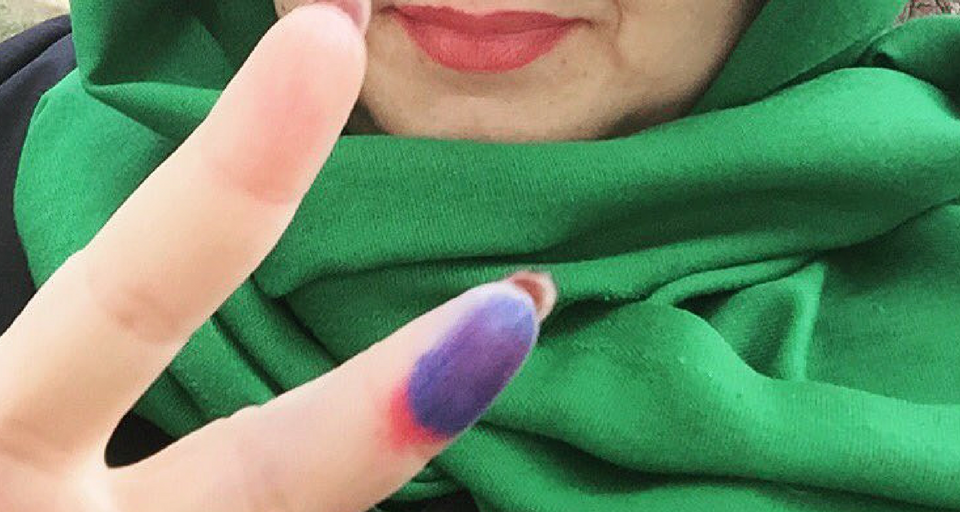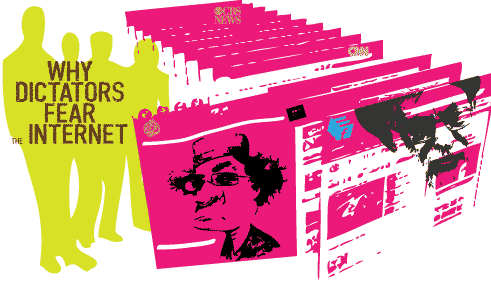
Two Faces of Revolution: (Or, why dictators fear the internet)
March 10, 2011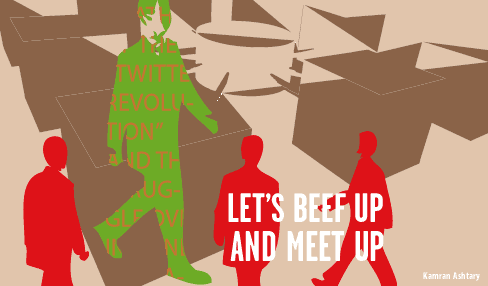
Let’s Beef Up and Meet Up
March 11, 2011Creating Social Capital in Politically Restrictive Environments: The Virtual Sphere and Iran’s Weblogistan
Christina Parisa Ashtary,University College London
View as single page
The public sphere can be best summed up as the “constellation of communicative spaces in a society that permits the circulation of information, ideas, debates, and the formation of political will and public opinion,” serving as the breeding grounds for a vibrant civil society.1 In open democracies, civic connectivity and engagement has produced a shared sense of collective trust and community norms, bounded through organization and collective action. While civic engagement in the public sphere is not always produced by political motivations, the very essence of social interconnectedness, collective force, and influence through social change will always carry political undertones.
To preserve power and political stability, many repressive regimes have taken measures to prohibit extensive civic engagement and bar the development of a free, civil society. In cases where engagement in the physical public sphere may be limited, a rise in virtual space has provided alternative mode for collective organization, linking closed societies to an open sphere of civic dialogue. The question remains then, can civic engagement in the virtual sphere allow repressed societies to create social capital equivalent to that seen in the open, democratic physical sphere? As we will examine later in this article, the power behind Iran’s Weblogistan has been playing a crucial role in developing ideologies, increasing interconnectedness, and strengthening social ties. Through the weblog and similar mediums of virtual communication, technology presents an alternative to traditional public space in engaging individuals, connecting society, and developing social trust.
Understanding Social Capital
In the same way one thinks of human capital as the valued knowledge and experience of an individual, social capital refers the value produced between relationships in society. Defining social capital, Putnam emphasized its “features of social organization such as networks, norms, and social trust that facilitate coordination and cooperation for mutual benefit.”2 Discussing the strengths among social connections, Granovetter established that strong ties relying on a consensual two-way relationship yielded higher levels of interpersonal trust, yet these ties were most often constrained to a smaller network with a limited social span. On the other hand, weak ties depended only on a mutual point of contact and could penetrate far deeper into social networks, yet due to distance, held less potential for creating strong linkages of interpersonal trust. When brought together by a mutual bond in a collective environment, weak ties strengthened their interconnectedness through interaction and face-to-face contact, in what Granovetter referred to as the bridging of social capital.3 Through this process of bridging connections under a collective interest, diverse communities could then become integrated, cohesive social units through a social network.
Repression of the Public Sphere: The Islamic Republic of Iran
Since the establishment of the Islamic theocracy in 1979, public spaces in Iranian society have been severely restricted. As it is stated in the Iranian constitution, the government allows for a “healthy encounter of different ideas,” but clearly does not permit any “propagation of destructive and anti-Islamic practices.”4 Realistically, a fine line exists between what is tolerated and what is forbidden by the state. Immediately seeking to repress individuality and lessen the threat of opposition, post-revolutionary Iran embarked on a decade of unity (Vahdat) to homogenize society and craft an obedient and controlled civil society.5 As Ebrahimi remarks of this period:
Large and crowded squares of the city were transformed to places in which any appearance, behavior and presence had to follow a pattern, consisting of bans and permissions. On the precise moment that the moral police was installed in the public spaces, all women tried to fix their hejab, girls and boys distanced themselves, laughter and loud voices were controlled, everything entered into the order of “andaruni.*6
Using citizens to enforce codes of behavior
During this time, the public sphere was politicized as the state forced civil society to closed, private spaces.7 To maintain power and legitimacy, the government followed popular methods for preserving authoritarian rule, limiting the development on the “self” and thereby inhibiting a fundamental building block of civil society. In addition to closing the physical public sphere, Iran successfully impeded on interpersonal trust through the strong societal emphasis on morality and Islamic ethical codes. In reviewing the government reliance on community policing, Ebrahimi notes that a strongly fortified traditional culture overpowered any need for state-sponsored surveillance initiatives, with everyday citizens enforcing the ethical codes of the government beyond the capabilities of the moral police.8
Nascent civil society
Despite Iran’s diminishing civic culture, the Khatami presidency from 1997-2005 marked some significant democratic reforms and the re-emergence of civil society. Increasing press freedoms, Khatami allowed reformist media sources to flourish in hopes of serving as counterinfluence to Iran’s closed political structure, and although a far cry from an independent media sector, the ease in restrictions allowed civil society to increase its presence in the public sphere.9 While this initiative lasted for only a few years, civil society had already began to reclaim the public space, and by 2000, Iran was estimated to have between 1,500 and 2,000 civil society organizations.10 In a sign of the changing times, these organizations began to increasingly place focus on issues of modern concern including women’s issues, which would have, in previous times, drawn much negative attention and government control.
Civil society is forced back into the closet
While the country saw a brief period of eased restrictions under the Khatami administration and embarked on a gradual path to develop civil society, liberalization under the reformist movement was soon put to a halt by government crackdowns from the conservative right. The election of Mahmood Ahmadinejad in 2005 was marked with tight government restrictions and suppression of civil liberties. Once again, people were forced out of public spaces and sought refuge in private, hidden spaces. Abolishing many of Iran’s civil society organizations, the government heavily regulated activities of remaining organizations, violating the “non-governmental” aspect and creating a blur between free, civil society and state influence and control. Yet, while the Iranian government tightened its grip on civil society and forced the masses out of this newly acquired space, it underestimated the increasing influence of the internet as a virtual public sphere.
The Rise of Weblogistan and a Virtual Society
In the past decade, the number of internet users in Iran has dramatically increased, with an estimated 38 percent of the country currently engaging in online mediums.11 The most common usage of online engagement can be seen in the blogosphere, or “Weblogistan,” as it is commonly referred to in Iran. In 2001, the introduction of a Persian character typing system combined with increased national access to the internet led to a drastic rise in Iranian bloggers.
With the fourth largest population of internet bloggers in the world, Iranians use blogging as a platform for personal expression, political commentary and debate, and open, unrestricted discussion.12 Where suppression of the physical public sphere has prevented personal expression and identity, this new virtual space provided as an outlet for society to resume in civic engagement. Journalists flocked to the blogosphere as a new medium to replace government-suppressed news and print media, while on a wider scale, Iran’s youth population used the platform as a vehicle for self expression, political commentary, and uncensored forms of discussion.13 For an increasingly homogenous society adhering to government standards to limit self expression in the physical public space, access to the internet has provided a revolutionary way for citizens to defy oppression and develop a sense of self through an otherwise restricted virtual public sphere.
Trust transfer
The anonymity of the virtual sphere serves as a positive influence in the Weblogistan. Because revealing one’s identity can be a risk to personal security, a significant amount of Iranian bloggers have taken on aliases or pseudonyms, protecting themselves from regime surveillance. Additionally, the faceless space of the virtual sphere has particularly empowered women, giving them a platform to surpass cultural traditions and deprived physical freedom which has prevented them from fully engaging in traditional space.14 Despite the anonymity available in internet engagement, many Iranian bloggers use their real names and identities, providing an added credibility to the testament of the blogger.15 There has been a demonstrative amount of trust transferred over from the physical public sphere, where reputations of well-known Iranian social figures facilitate social trust in these virtual communities.16
The virtual sphere has allowed the community to transcend geographical boundaries on a macro-level and develop social relationships with members outside of Iran. From notable Iranian expatriates to everyday migrants to societal liberators, the breadth of this community has created dialogue between a very diverse set of members and has thus bridged ties spanning across continents. In connecting the outside world with civil society in Iran, the virtual space has also allowed a global population to contribute additional thoughts, ideas, and human resources. The delivery of social empowerment tools to expand the capacity of the Iran-based network is one example of physical resources made available though the virtual space, where organizations like Tavaana.org and ArsehSevom.net have provided learning courses and information specifically relevant to Iran to further empower civil society.17 Without the access given through this virtual space, such initiatives would never physically reach Iranian society.


